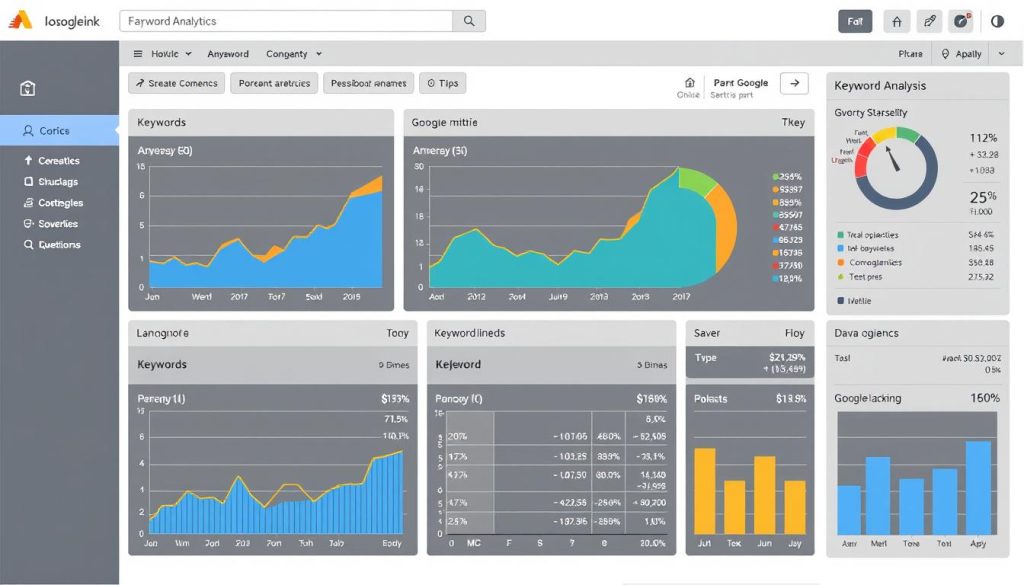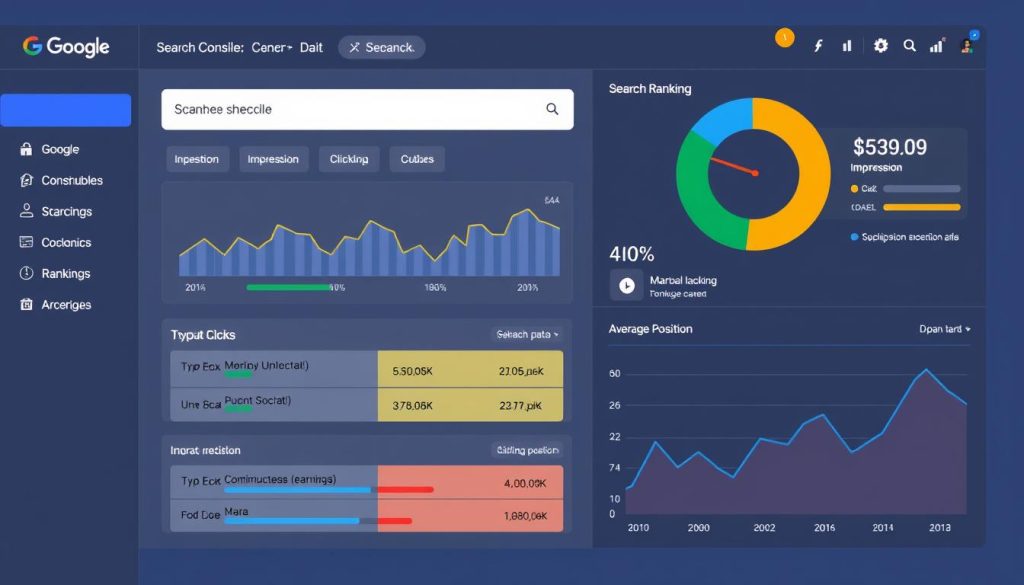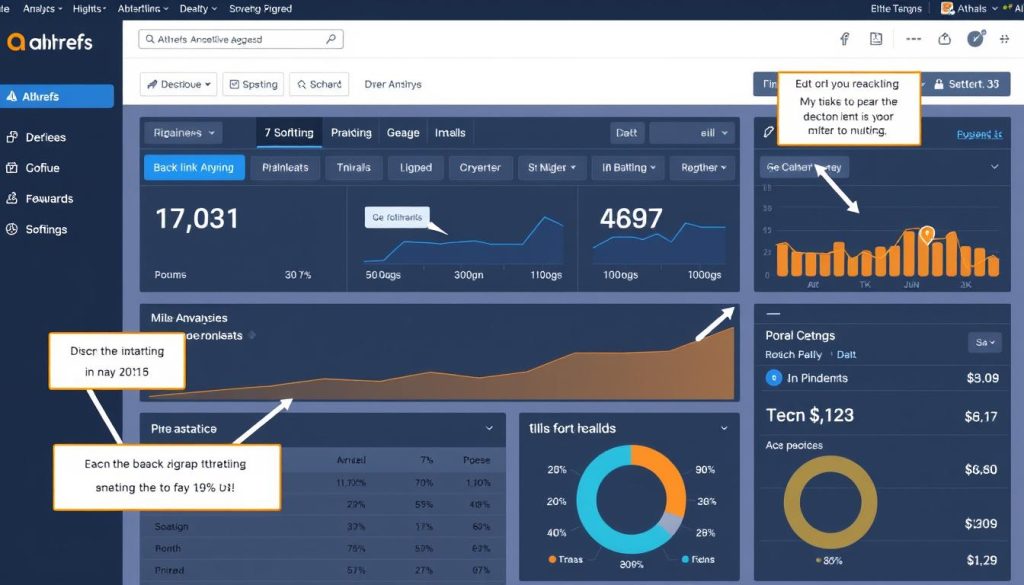In today’s digital landscape, making informed decisions is crucial for the success of your online business. With the vast amount of data available, understanding how to leverage SEO analytics can be a game-changer for your digital marketing efforts.
By analyzing raw data, you can better inform your search engine optimization efforts, prioritize tasks, and make better decisions to improve your online visibility. This comprehensive guide will explore how to use SEO analytics to enhance your digital marketing strategy, from setting up essential tools to creating actionable reports that drive business growth.
Table of Contents
Key Takeaways
- Understand the importance of data-driven decision making in digital marketing.
- Learn how to collect and analyze search engine data to identify growth opportunities.
- Discover how to optimize your content strategy and improve online visibility.
- Find out how to track key metrics to measure the effectiveness of your SEO efforts.
- Explore the benefits of moving beyond guesswork to implement data-based strategies.
Understanding SEO Analytics
Making informed decisions about your SEO efforts requires a deep understanding of SEO analytics. To prioritize and secure approval for your SEO initiatives, you must know what’s working and what’s not for your website. This knowledge enables you to make rational decisions, aligning your SEO efforts with your overall goals.
What Is SEO Analytics?
SEO analytics involves the collection, analysis, and interpretation of data related to your website’s search engine performance. This includes understanding how users interact with your site, tracking keyword rankings, and analyzing traffic patterns. By leveraging SEO analytics tools, you can gain valuable insights into your website’s strengths and weaknesses.
Why Data-Driven SEO Matters
A data-driven SEO approach eliminates guesswork from your marketing strategy, allowing you to make decisions based on concrete evidence rather than assumptions. By analyzing SEO metrics, you can determine which SEO efforts are contributing to your goals and which are not. This enables more efficient resource allocation, focusing on tactics that are most effective for your audience and market.
| Benefits of Data-Driven SEO | Description |
|---|---|
| Eliminates Guesswork | Makes decisions based on concrete evidence |
| Measures ROI | Demonstrates clear return on investment for SEO initiatives |
| Optimizes Resource Allocation | Focuses efforts on effective tactics |
By adopting a data-driven SEO strategy, you can improve your website’s search performance and drive more traffic to your site. This, in turn, can lead to increased conversions and revenue, ultimately enhancing your overall digital marketing strategy.
Essential SEO Metrics to Track

To maximize the effectiveness of your SEO strategy, it’s crucial to track the right metrics. SEO analytics provides insights into how your website is performing in search engine results, helping you make informed decisions to improve your online presence.
Keyword Performance Metrics
Keyword performance metrics are vital for understanding how your target keywords are driving traffic to your website. Key metrics include keyword rankings, search volume, and click-through rates (CTR). By analyzing these metrics, you can identify opportunities to optimize your content and improve your search engine rankings. Regular monitoring of keyword performance helps you stay ahead of the competition.
| Metric | Description | Importance |
|---|---|---|
| Keyword Rankings | Position of your website for target keywords | High |
| Search Volume | Average number of searches for a keyword | Medium |
| CTR | Percentage of users clicking on your website | High |
Traffic and Engagement Metrics
Traffic and engagement metrics provide insights into how users interact with your website. Key metrics include organic traffic, bounce rates, and average session duration. By analyzing these metrics, you can identify areas for improvement to enhance user experience and increase engagement. Organic traffic is a critical metric, as it indicates the number of visitors coming from search engines.
Conversion and Revenue Metrics
Conversion and revenue metrics are essential for understanding the ROI of your SEO efforts. Key metrics include conversion rates, revenue generated from organic search, and goal completion rates. By analyzing these metrics, you can determine the effectiveness of your SEO strategy in driving business outcomes. Revenue attribution models help you understand the financial value generated by organic search compared to other marketing channels.
- Conversion metrics connect SEO efforts directly to business outcomes by tracking how organic search visitors complete desired actions on your website.
- Goal completion rates for organic traffic provide insights into how effectively your SEO strategy is targeting visitors with high conversion potential.
- Revenue attribution models help determine the financial value generated by organic search compared to other marketing channels.
Setting Up Your SEO Analytics Process
Understanding how to set up your SEO analytics is key to unlocking data-driven insights that can significantly enhance your digital marketing strategy. With the right setup, you can ensure that your SEO efforts are yielding the desired results and make informed decisions to improve your online presence.
Establishing Roles and Responsibilities
A crucial step in setting up your SEO analytics process is to clearly define the roles and responsibilities within your team. This ensures that everyone is aware of their tasks and can work collaboratively to achieve your SEO goals. By assigning specific roles, you can streamline your workflow and enhance productivity.
Determining Analysis Frequency
Deciding how often to analyze your SEO data is vital. The frequency of analysis depends on your business needs and the scope of your SEO efforts. Regular analysis, whether weekly, monthly, or quarterly, helps you stay on top of your SEO performance and make timely adjustments.
Creating a Data Collection Framework
A robust data collection framework is essential for capturing all relevant SEO metrics from multiple sources in a consistent and organized manner. This framework should include primary data sources like Google Analytics and Google Search Console, as well as supplementary tools such as rank trackers and backlink analyzers. By implementing a comprehensive framework, you can ensure that your data collection is thorough and reliable.
- Implementing proper tracking codes and setting up accurate goal tracking is essential for collecting reliable data.
- Automating data collection where possible reduces manual effort and minimizes the risk of human error.
- Your framework should include processes for data validation to ensure the information you’re collecting is accurate and complete.
Core SEO Analytics Tools
To maximize your SEO efforts, it’s crucial to leverage the right analytics tools. These tools provide insights into your website’s performance, helping you make data-driven decisions to enhance your digital marketing strategy.
Google Analytics
Google Analytics is a powerful tool for tracking your website’s traffic, engagement, and conversion metrics. It helps you understand how users interact with your site, allowing you to refine your SEO strategy. With Google Analytics, you can monitor keyword performance, track user behavior, and measure the effectiveness of your SEO efforts.

Google Search Console
Google Search Console is another essential tool for SEO analytics. It provides insights into your website’s search visibility, helping you identify areas for improvement. With Google Search Console, you can monitor your website’s search rankings, track keyword impressions, and identify technical SEO issues.

Third-Party SEO Tools
While Google’s free tools are incredibly valuable, there are instances where you’ll need to invest in third-party SEO tools to collect comprehensive data. Tools like Ahrefs, SEMrush, and Moz offer advanced features for competitive analysis, keyword research, backlink monitoring, and technical SEO audits. These tools help you monitor keyword positions across multiple search engines, evaluate your link profile’s quality, and identify new link-building opportunities.
- Third-party SEO tools complement Google’s free offerings by providing specialized features for competitive analysis, keyword research, backlink monitoring, and technical SEO audits.
- Popular platforms like Ahrefs, SEMrush, and Moz offer comprehensive suites of tools that provide deeper insights than what’s available in Google’s free analytics platforms.
- Rank tracking tools allow you to monitor keyword positions across multiple search engines, locations, and devices, providing a more complete picture of your search visibility.
- Backlink analysis tools help evaluate your link profile’s quality and identify new link-building opportunities that can improve your domain authority.
- Technical SEO audit tools can crawl your website to identify issues that might be hindering performance, providing actionable recommendations for improvement.

Analyzing SEO Data Effectively

To maximize your website’s potential, analyzing SEO data effectively is key. This involves a comprehensive approach to understanding your website’s performance, identifying areas for improvement, and making data-driven decisions to enhance your SEO strategy.
Identifying Underperforming Keywords
One crucial aspect of SEO data analysis is identifying underperforming keywords. This involves reviewing keyword performance metrics, such as search volume, click-through rates, and conversion rates. By doing so, you can pinpoint keywords that are not driving the desired traffic or conversions and adjust your content strategy accordingly.
For instance, you can use tools like Google Analytics and Google Search Console to analyze keyword performance and identify areas for improvement. By regularly monitoring and adjusting your keyword strategy, you can optimize your content to better resonate with your target audience.
Analyzing Content Performance
Analyzing content performance is another vital aspect of SEO data analysis. This involves evaluating metrics such as page views, engagement rates, and bounce rates to determine which content is resonating with your audience and which needs improvement.
By understanding how your content is performing, you can refine your content strategy to create more engaging and relevant content that drives results. This may involve optimizing existing content, creating new content around high-performing keywords, or adjusting your content format to better suit your audience’s preferences.
Evaluating Backlink Quality
Evaluating backlink quality is essential for understanding your website’s authority and trustworthiness. This involves analyzing the authority, relevance, and trustworthiness of sites linking to your content, rather than just counting the total number of links.
| Metric | Description | Importance |
|---|---|---|
| Domain Authority | Measures the credibility of a linking domain | High |
| Trust Flow | Assesses the trustworthiness of a linking site | High |
| Citation Flow | Measures the number of links to a site | Medium |
By using tools like Site Explorer, you can delve deeper into backlink analysis and identify opportunities to improve your backlink profile. This can involve strategies such as guest blogging, content partnerships, and outreach to relevant sites in your industry.
Creating Actionable SEO Reports and Dashboards
The key to successful SEO analytics lies in creating reports and dashboards that drive strategic decisions. To achieve this, it’s essential to have a clear understanding of how to present complex SEO data in a concise and actionable manner.
Visualizing SEO Data
Visualizing SEO data is critical for making it accessible to both SEO professionals and clients. By using charts, graphs, and other visualization tools, you can help stakeholders quickly understand the insights and trends in the data. This enables them to make informed decisions about their SEO strategy.
Building Client-Friendly Reports
When building SEO reports for clients, it’s essential to focus on the metrics that matter most to them. This may include keyword rankings, traffic, and conversion metrics. By tailoring your reports to the client’s needs, you can provide them with actionable insights that drive results.
- Identify the key performance indicators (KPIs) that are most relevant to the client’s goals.
- Use clear and concise language in the report, avoiding technical jargon whenever possible.
- Provide recommendations for future SEO efforts based on the data and insights presented in the report.
Automating the Reporting Process
Automating the SEO reporting process can save significant time and resources while ensuring consistency and reducing human error. By leveraging reporting tools that can connect to multiple data sources, you can streamline your reporting process and focus on higher-level tasks.
Some benefits of automating the reporting process include:
- Scheduled reports can be set up to generate and distribute at regular intervals.
- Real-time or near-real-time dashboards can be accessed by clients whenever they need updated information.
- Templates and white-labeling features enable agencies to maintain brand consistency.
Turning SEO Analytics Into Strategic Decisions
With SEO analytics, organizations can turn complex data into clear, actionable strategies that improve their search engine rankings. This process involves analyzing various metrics to inform decisions that drive business growth.
Content Optimization Strategies
Content optimization is a critical aspect of SEO. By analyzing keyword performance and content pages, businesses can identify areas for improvement. This involves optimizing existing content to better match user intent and creating new content that targets high-value keywords.
Technical SEO Improvements
Technical SEO improvements are essential for ensuring that a website is crawlable, indexable, and provides a good user experience. Analytics data can highlight technical issues, such as slow page speed or poor mobile usability, that need to be addressed. By fixing these issues, businesses can improve their website’s overall performance and search engine rankings.
Competitive Analysis Insights
Competitive analysis provides valuable insights into what works for industry leaders. By analyzing competitors’ backlinks and content strategies, businesses can identify gaps in their own SEO efforts and opportunities to improve. This involves tracking competitors’ ranking changes over time to adapt strategies accordingly and achieve better results.
Conclusion: Mastering SEO Analytics for Long-Term Success
As we conclude our exploration of SEO analytics, it’s clear that data-driven insights are crucial for long-term success. Mastering SEO analytics is not a one-time achievement but an ongoing process of learning, testing, and refining your approach as search engines and user behaviors evolve.
To achieve sustainable growth, it’s essential to balance quick wins with strategic initiatives that build organic search visibility over time. Developing a data-driven culture within your organization ensures that SEO decisions are based on evidence rather than assumptions or outdated practices.
For more information on building a robust SEO strategy, including effective link building techniques, visit our comprehensive guide on building quality links. By regularly reviewing and refining your analytics process, you’ll be able to track the right metrics and draw the correct conclusions from your data, driving improved performance and increased traffic over time.
FAQ
What is the primary goal of using SEO analytics in digital marketing?
The primary goal of using SEO analytics is to measure the effectiveness of your search engine optimization efforts and inform data-driven decisions to enhance your online presence and drive business growth.
How often should I analyze my SEO data?
The frequency of analyzing SEO data depends on your business needs and goals. Regular analysis, such as monthly or quarterly, can help you stay on top of your SEO performance and identify areas for improvement.
What are the key SEO metrics to track for business growth?
Key SEO metrics to track include keyword performance, traffic and engagement metrics, conversion and revenue metrics, and backlink quality. These metrics provide insights into your website’s visibility, user engagement, and overall SEO performance.
How can I use Google Search Console to improve my SEO efforts?
Google Search Console provides valuable insights into your website’s search engine rankings, impressions, and clicks. You can use this data to identify underperforming keywords, optimize your content, and improve your website’s technical SEO.
What is the role of keyword research in SEO analytics?
Keyword research plays a crucial role in SEO analytics as it helps you identify relevant keywords and phrases your target audience uses to search for your content, products, or services. This information can inform your content optimization strategies and improve your website’s visibility.
How can I measure the ROI of my SEO efforts?
To measure the ROI of your SEO efforts, you can track metrics such as organic search traffic, conversion rates, and revenue generated from organic search. By comparing these metrics to your SEO costs, you can calculate the return on investment and evaluate the effectiveness of your SEO strategy.
What are some common challenges in implementing SEO analytics, and how can I overcome them?
Common challenges in implementing SEO analytics include data quality issues, lack of expertise, and difficulty in measuring ROI. To overcome these challenges, you can invest in SEO tools, develop your team’s SEO skills, and establish clear goals and metrics to track.





